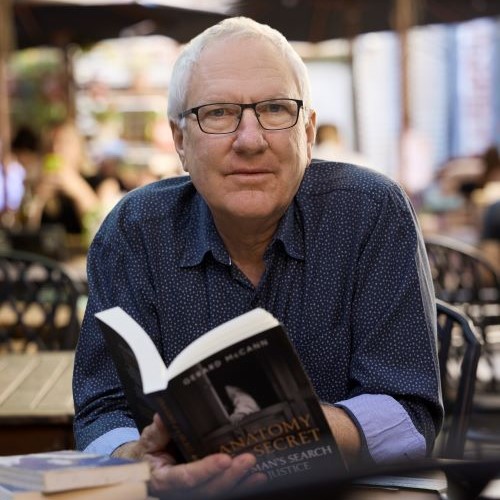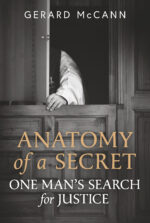Anger drove Gerard McCann to write down the experiences of his childhood – empathy gave him the resilience to hear his story with others

Anatomy of a Secret by Gerard McCann was shortlisted for the 2022 City of Fremantle Hungerford Award. Publisher Georgia Richter says, ‘Gerard McCann’s memoir documents the experiences of a Catholic boy who was just one of scores of young boys sexually assaulted by convicted paedophile Leo Leunig in Perth in the 1960s. Despite the confronting nature of the subject matter, this memoir is immensely readable, honest and unadorned in its delivery, and generous in its perceptions and sharing.’ Earlier this year she conducted this interview with the author.
What inspired you to publish this memoir?
The initial impetus to write my story was anger. I unexpectedly came across the story of how the Catholic Church had run a secret and highly expensive rehabilitation and support program for paedophile clergy at a psychiatric clinic in Sydney. The program had operated in the 1990s and into the 2000s and had treated over a thousand clergy. The offenders were not reported to the police. At the completion of their ‘rehabilitation’, they were given a generous payout, accommodation and a university education and transitioned out of their Holy Orders. During this time, and before and after, the Church had been strenuously challenging and demeaning victims in the courts and in the press, denying them the ‘truth’ of their experiences. My rage was volcanic and I spilled my story to some close friends, who encouraged me to write it down. This process took on a life of its own as the story unfolded in a narrative non-fiction mode, where my feelings and experiences as I wrote and investigated the web of abuses became an integral part of telling the story. After seven years of writing, author Emily Bitto was referred to me to help finetune the manuscript, and after several edits she encouraged me to submit it for publication and competitions. Being shortlisted for the 2022 City of Fremantle Hungerford Award affirmed that publication was possible.
Writing, integral with psychotherapy, became a healing journey as it allowed me to externalise facts and feelings, helping me to understand and live with the wounds rather than bury them. As I uncovered more of the horror other victims had suffered, and the extent of the paedophile priest’s offending, the scope of my story widened. It became an exploration of the priest and his times, as well as a documentation of the Church’s responses to abuse generally, and to me specifically. I came to understand that the consequences of abuse, for me and the other men I interviewed, were universal and should be exposed to a wider audience. In this, I was encouraged by those survivors whose stories I had recounted. Not only were they very supportive of our collective story being told, they reported that reading my manuscript had helped them to a greater understanding of what had happened to them, a validation of their experience and their anguish.
Therapy has been such an integral part of your journey to reclaiming your sense of self. You participated in a number of different kinds of therapies – how was it that you knew psychotherapy at the Sexual Assault Resource Centre (SARC) was the right one for you?
I did not know. It was extraordinarily good fortune. I was attempting to contact the police to report my abuse and inadvertently rang the Sexual Assault Resource Centre in Subiaco. When they suggested counselling, I presumed they were a ‘sorting house’, a preamble to reporting the crimes upstream to the police. As it turned out, it was to become another bout of therapy, which I was always open to. Once again, I found myself trying to get to the nub of the disconnect between ‘me’ and my missing feelings. I knew something was seriously wrong but I had no idea what that was, only experiencing it as profound disempowerment and constant rage.
At SARC, I was teamed up with James N. He miraculously was the right person with whom I was able to develop a level of trust. Over several years, he skilfully led me to that place where the traumas were held in my body, around my heart, and he slowly guided me in bringing them into the light of day. Our process was highly intuitive, a two-way interpersonal exchange, an integrative approach of many disciplines, narrative therapy, somatic therapy, interpersonal psychotherapy and others, including some CBT [cognitive behavioural therapy]. This therapeutic experience was life-changing but highly disruptive, as the turmoil of a lifelong ‘trauma suppression system’ was exposed and dismantled – essential, however, for the reconstruction of the fragmented child-self.
Did the act of writing lead to any unexpected revelations? Were there some you left out of the book?
Yes. I was constantly surprised at the memories and feelings that surged into view as I wrote. Even though I have a video-like memory of whole scenes and conversations and events surrounding the abuses, the terror and feelings of helplessness associated with those memories was not available consciously, only appearing in nightmares that had haunted my whole life. I had no doubt as to the veracity of the suppressed feelings as they emerged, as often tears accompanied them. Sometimes they were so overwhelming, I sobbed.
Importantly, the recollections reclaimed my inner voice, the internal monologues that had occurred at critical moments of my childhood. This voice had not only named my feelings at those times, but also contemplated the moral consequences of my position. I also became very conscious of the potential problem of reliable childhood recall, a much fraught topic in judicial and literary contexts. In my case, the colour of the church at Kwolyin was a case in point. I remember it as being grey-green, but it is in fact red. I felt fortunate though that I had been very conscious of my feelings at the time, and so remembering these inner conversations, indelibly burned somewhere, were the means to access them. The feeling of revelation and release that accompanied their re-emergence testified to their truth.
There have been elements that have been left out of the book. There were many issues that dogged my young adulthood and their listing seemed repetitive. I edited these down to the most profound, sufficient to give a picture of myself working with what had happened and what I was to do with it. My married life, my parenting and my career as an architect occupy about three-quarters of my life, and though the childhood traumas occupied less than one-twentieth of that time, their effect echoed throughout. So there is much in between that has had to be distilled down to key moments of insight and experience, sufficient to describe the essence of the journey.
What’s next for Gerard McCann?
I have retired as an architect and will let the dust of that career settle for as long as it takes to be able to see into the distance. In the past, writing has sprung to life when I have removed the yoke of otherworldly tasks and responsibilities. There are drawers full of material, but where or what they may lead to remains to be seen. That said, I love the surprise of seeing words appear on the page, seemingly from nowhere, but generated from a lifetime of watching and noting.
Anatomy of a Secret will be launched at Kidogo Arthouse this Thursday 2 May and is available in all good bookstores and online.
To listen to a reading from the book click here.



